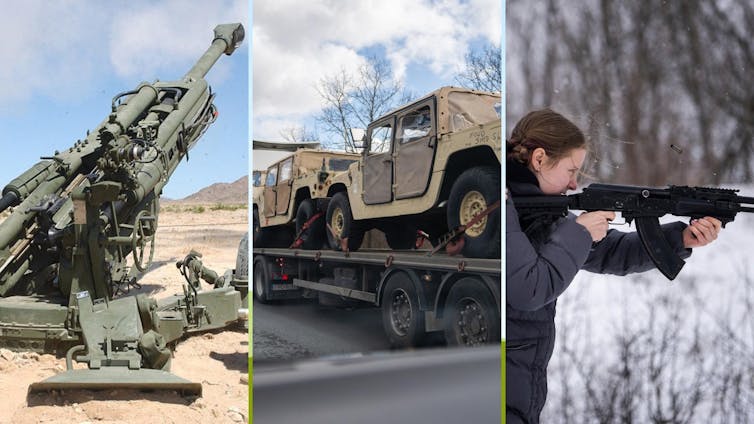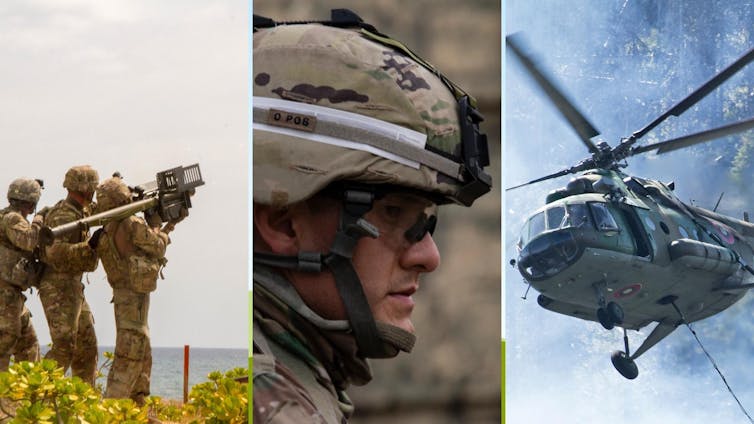Ukraine receives weapons support from around the world
An arms trade expert explains the wide variety of military aid nations around the world have sent to Ukraine.

Since Russia invaded Ukraine in February 2022, many of the world’s nations have sought to support Ukrainians by sending weapons. Even before that, though, many countries were offering limited help as a result of the Russian takeover of Crimea, in southern Ukraine, in 2014.
The United States has given more than US$3 billion in military aid and has sold an additional $165 million worth of weapons to the country. New legislation suggests that this number will continue to rise, both through a streamlined process of lending or leasing equipment to Ukraine and an additional $20 billion in military aid Biden has asked Congress to approve.
As an arms trade researcher and a policy analyst at the Cato Institute, I have observed that some countries have supplied items like tanks and helicopters. These help Ukraine prevent Russia from capturing and holding Ukrainian territory. But they are not the majority of weapons transfers. The four main categories of weapons that the West has sent Ukraine are basic guns and ammunition, missiles, attack drones and artillery.
Firearms
Guns and ammunition make up a large amount of the transferred weapons. The U.S. has sent Ukraine over 50 million rounds of ammunition for handguns, rifles and artillery. Canada, Greece, Lithuania, the Netherlands, Poland, Portugal, Romania and Slovenia have also supplied ammunition.
The usefulness of guns and ammunition is fairly straightforward: Without them, Ukrainian soldiers – and the civilians who have joined them – cannot defend themselves. This equipment is also simple to learn how to use, and relatively small and lightweight, making it easy to ship large amounts from one country to another.

Missiles
Countries have provided Ukraine with anti-tank, anti-aircraft and anti-ship missiles, most notably the anti-tank Javelin. To date, the U.S. has provided more than 7,000 Javelins to Ukraine, and Ukrainian troops are reportedly finding them effective against Russian tanks.
Anti-tank missiles like the Javelin are easy to use, with military experts claiming it takes only 30 minutes to learn. Moreover, once fired, the Javelin requires no input from the gunner. This means that the user can fire the weapon and then flee combat without needing to steer the missile to its target.
The U.S. is currently shipping more Javelins to Ukraine than it can easily replace, so the U.S. supply may soon dwindle.
In addition, other countries are sending anti-aircraft missiles and missile systems to Ukraine. Stinger missiles are the anti-aircraft equivalent of the Javelin anti-tank weapon, light enough for one person to carry and fire, with no steering needed after firing. They can hit targets a maximum of only about 5 miles away.
German-made Gepard air-defense tanks are fast-moving armored anti-aircraft vehicles that can hit aircraft as far away as 10 miles.
The S-300 launching system, originally developed for the Soviet Union but now also used in Asia and by Slovakia and Slovenia, among other eastern European nations, is being transferred by Slovakia to Ukraine. It has a range of nearly 125 miles.
The S-300s and the Gepards are better than Stingers at fighting Russian drones, which Russia is using to fire bombs and missiles at distant targets in Ukraine.
Transfers of anti-ship missiles by the United Kingdom to Ukraine aim to prevent Russia from blockading Ukraine’s Black Sea ports.

Attack drones
Ukraine is using so-called “attack drones” made by the U.S. and Turkey to destroy Russian tanks and artillery. These weapons tend to be small – for example, the Switchblade drone that the U.S. is sending is 2 feet long and weighs 6 pounds. They range in capabilities but can destroy Russian tanks and artillery emplacements. Additionally, they were used to distract Russian missile defenses as decoys when attacking Russian ships.
[Over 150,000 readers rely on The Conversation’s newsletters to understand the world. Sign up today.]
The U.S. is considering sending more advanced drones, such as the MQ-9 Reaper, which is twice as fast as the drones Ukraine is using now. The Reaper is also able to be controlled from more than 1,000 miles away – unlike the smaller drones, which need a controller to be within about 100 miles. There are concerns about whether international law might limit U.S. shipments of Reapers to Ukraine – and whether it would further entangle NATO in the war.
Artillery
Finally, countries have also recently begun sending Ukraine artillery, or large-caliber guns used for land warfare. The reason for sending these more advanced systems is that Russia is trying to “use long-range shelling to drive back most of Ukraine’s forces and only then send in ground troops and tanks to secure the land,” according to one analysis.
In this situation, artillery, while requiring more advanced training and more than one person to operate, has greater range than traditional ammunition and can help Ukraine continue to wear down the Russian forces, who still outnumber them.
The international military support for Ukraine is preventing Russia from holding land and establishing air superiority. If this continues, Russia will need to figure out a different way to wage war, one in which it can take and hold Ukrainian territory.
Jordan Cohen is a Policy Analyst in Defense and Foreign Policy Studies at the Cato Institute and a PhD candidate in political science at the Schar School of Policy and Government at George Mason University. He is also an emerging expert at the Forum on the Arms Trade.
Read These Next
How to reduce gift-giving stress with your kids – a child psychologist’s tips for making magic and a
Depending on family circumstances and a child’s personality type, gift giving runs the gamut of fun…
The world risks forgetting one of humanity’s greatest triumphs as polio nears global eradication − 7
Polio may finally be defeated in the next 5 years. Will the world recognize what an extraordinary achievement…
Why are some Black conservatives drawn to Nick Fuentes?
Black Americans and white nationalists have joined forces in the past. And a number of cultural and…






